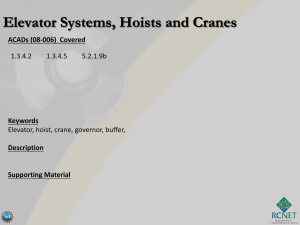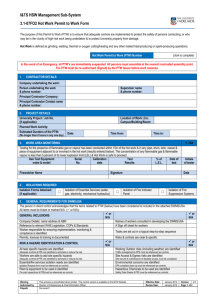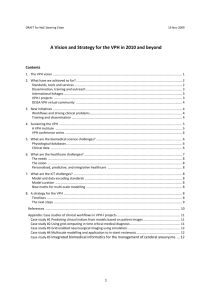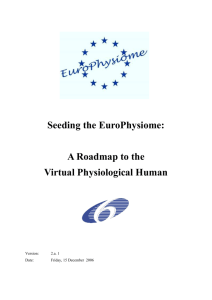Capital Structure
advertisement
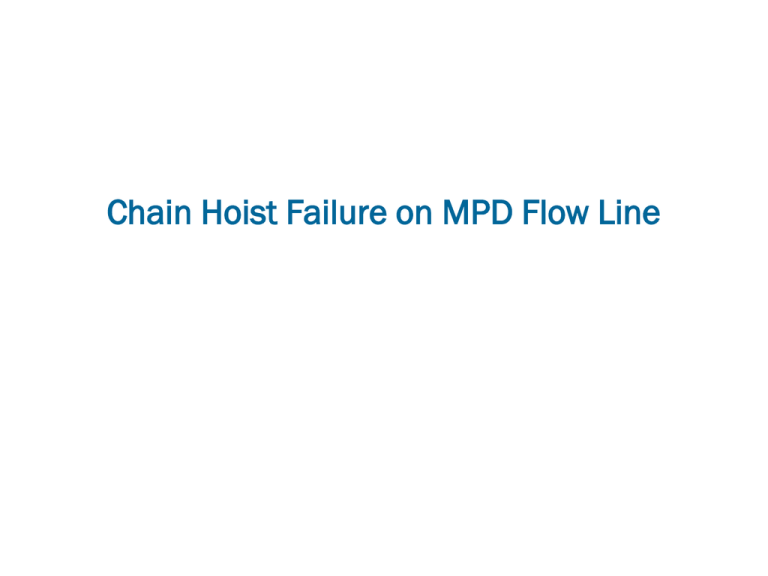
Chain Hoist Failure on MPD Flow Line Chain Hoist Failure • BOP and Riser running operations completed after an extensive repairs and maintenance period while the BOP was on surface. • Managed Pressure Drilling (MPD) choke and lines had to be rigged up: two 3rd Party Contractor personnel & one Company personnel. • Section of pipe (3.2mx320kg) required to be installed on the lower platform of the BOP transporter. A 1T chain fall was added to provide additional reach • PTW & JSA in place; however, Area Supervisor did not review the PTW and JSA correctly. • Agreed amongst the team that the Contractor supervisor would operate the auxiliary hoist • Hook not directly above the load; intention to man-handle the pipe clear of obstructions, no consideration for tag lines. • During the lift the pipe was seen to get caught under the flange. Both personnel made attempts to stop • Operator did not respond and continued to hoist the load, the upper chain hoist hook stretched beyond its elastic limit, reached its yield point, and the load dropped Our World is Getting Deeper 2 Chain Hoist Failure • The entire assembly with rigging fell to the deck, part of the rigging struck the IP’s hard hat and knocked it off his head. The IP sustained a superficial 1.5cm laceration to his forehead as a result. • DROPS calculator indicates Probable Fatality for the 7kg chain hoist. Our World is Getting Deeper 3 Chain Hoist Failure Our World is Getting Deeper 4 Chain Hoist Failure Summary: Critical Factors Inadequate control of lift allowed the load to be caught under the overboard valve flange resulting in overload and failure of the chain hoist Improper positioning of people allowed IP to be in an unsafe position. Immediate/System Causes Inadequate control of 3rd Party Contractor – Bridge crane operated by 3rd Party Contractor contrary to Company Policy – Company AD allowed this to happen Poor leadership by Area Authority – Task not fully understood; worksite and controls not audited before endorsing the PTW & JSA Inadequate implementation of PNA safety processes by the team – JSA completed but not appropriate for the task. The supporting T5 risk assessment process not followed and therefore appropriate controls not identified and implemented. – No lifting plan, no tag lines, hands on load where not required, no additional supervision, positions of people, no dedicated banksman. Our World is Getting Deeper 5 Chain Hoist Failure • Safety Stand Downs to be performed by Company Management; application of HSE policy in relation to the incident to be a primary focus. • Post lists of trained and approved operators of mechanised handling equipment • 3rd Party Contractors to take immediate CoW refresher training & 3 monthly thereafter. • Develop specific JSA for MPD rig up and rig down • Amend Job Descriptions to include clear expectations of an Area Supervisor within the roles and responsibilities, to be reviewed with the OIM and countersign. • Area Supervisor will cascade the HSE Policy presentation to his team including 3-5 of his personal expectations. • Review effectiveness & implementation of the following and amend as necessary: • 3rd Party Inductions & 3rd Party Management • Lift Planning & Lifting Guidelines • Better planning of work • Update PTW manual to include the requirement for periodic site visits by Area Supervisors. Record of PTW signatories will be updated to ensure the requirement is effectively communicated. Our World is Getting Deeper 6 DROPS HiPo Summary Whilst running in the hole with 5 1/2” drill pipe, a service loop retainer bar on the vertical traverse arm of the Upper Bridge Racking Crane fell to the rig floor. The retainer bar broke free from its mounting on the upper bridge racking crane, when it contacted a stand of drill pipe that was racked back in the forward setback area. Background Whilst making a connection at the rotary table an alarm tripped within the Zone Management System due to equipment proximity & collision risk. In order to clear this the Pipe Handling Operator utilised a “Manual Mode” which allowed a greater range of operational envelope for the Vertical Pipe Handler and an increased risk of collision with the setback. Our World is Getting Deeper 7 DROPS HiPo During the installation and commissioning of the VPH the BRC service loop was identified as a possible snagging point on the Top Drive. Concerns were raised and consideration given to a modification, possibly a drag chain. The drag chain required engineering and support from specialist contractor thus was not an instant fix; an interim solution utilised by Company on two other similar systems in its fleet was therefore installed; this was retro fitted retention loop. Our World is Getting Deeper 8 DROPS HiPo As a temporary measure a retaining bar was fitted. The material utilised was 16mm stub bar approximately 430mm in length and formed into the required shape. It was covered with heavy duty wire spiral in order to prevent chaffing of the loops on the thread. There is/was no Management of Change (MOC), or Request for Engineering Support (RES) in place for this modification. The positioning of the retaining bar is indicated top right, the bar following the DROPS bottom right. Our World is Getting Deeper 9 DROPS HiPo Whilst working to overcome the Zone Management System alarm the VPH was operated in manual mode and came into very close proximity to the setback, as depicted in the photograph. The retainer bar struck against the setback and subsequently fell as a result of the contact. The PHO was aware of the proximity and stated that he did see a slight contact with the service loop and setback. Our World is Getting Deeper 10 DROPS HiPo A person crossing the aft drillfloor from the doghouse heard the retaining bar fall and investigated. He was approximately 3m away at the time of impact. DROPS calculator indicates a FATAL outcome had he been struck. Our World is Getting Deeper X 11 X Possible Immediate Causes Actions 3 Use of protective equipment or methods 3.5 Disabled guards, warning systems or safety devices The use of Manual whilst it is a required operating mode, effectively removes certain parameters from the system thus allowing a greater range of movement and the possibility for collision into the setback. Conditions 4 Lack of focus or inattention 4.6 Routine activity without thought Manual mode is utilised frequently without any real consideration given to the hazards that are inherent in its use, particularly whilst operating in proximity to the setback. 5 Protective systems 5.1 Guards or protective devices not effective The design of the retaining bar was woefully inadequate as a working solution. A sturdier, better engineered, & none threaded bar should have been fitted. Our World is Getting Deeper 12 Possible System Causes Personal factors 13 Behaviour 13.1 Antecedent not present No prompt present in the PHO cabin in the form of a placard/sign as a reminder that Manual mode requires extra care and attention when in use. 13.2 Antecedent not effective Previous training regards certain limitations of the system being removed in Manual mode, plus his seeing the VPH in close proximity to the stands were not enough to cause him to stop and rethink the operation. Job factors 15 Training/Knowledge Transfer 15.3 Knowledge Transfer Not Effective A well established OEM course was delivered, the practical aspect reiterating the requirement to pay extra care and attention in manual mode. This however was not effective in this case at driving home the importance of paying attention whilst in Manual/Direct Mode. Our World is Getting Deeper 13 Possible System Causes (continued) Conditions 16 Management/supervision/employee leadership 16.10 Risk analysis not effective A lack of understanding by senior personnel with regard the potential hazards inherent whilst operating in Manual mode. 18 Engineering/design 18.1 Technical design not correct The design of the retaining bar was woefully inadequate as a working solution. A sturdier, better engineered, & none threaded bar should have been fitted. The design should have been appropriately reviewed by several personnel and approved through the proper channels utilising management of change. 18.5 Assessment of Operational Effectiveness not Effective Retainer bar installation occurred after VPH commissioned with no revalidation of acceptance. Our World is Getting Deeper 14 Possible System Causes (continued) 19 Control of Work (CoW) 19.2 Risk assessment not effective A general lack of understanding with regard the potential hazards inherent whilst operating in Manual mode was apparent; no mention of hazards related were present on the JSA. 22 Standards/Practices/Procedures (SPP) 22.2 Development of SPP not effective Procedure for tripping with the VPH made no mention of Manual Mode, therefore any review and subsequent JSA would not incorporate the hazards associated as a result. 23 Communication 23.2 Vertical communication between Supervisor and Person not effective Communication between the Driller and PHO did exist but was not effective via the talk-back system. The driller had to resort to using the telephone in order to effectively communicate. 23.4 Communication between work groups not effective Final installation of the retaining bar was not properly communicated between the project and operation team; the operation team had little input into the design and were not provided with any follow up information following the installation. Our World is Getting Deeper 15 Action Items Operating Procedure (s) to be updated JSA to be developed regarding VPH Operating Modes JSA to be updated to include hazards related to utilising Manual/Direct mode. Develop, install, & commission permanent retaining method for service loop Implement interim inspection plan to reduce potential damage service loop Installation of Rig Floor Color Coding of Hazardous Areas Evaluate Enhanced Communication Capabilities between Driller & PHO Complete installation of lights/alarms on Lower Guide Arm on rig floor Hazard ID training (with specific focus on VPH) Contractor Operator Training to be reviewed Evaluate/implement method to reduce use of Manual Mode Any after market/non-OEM modifications subject to rigorous MOC and testing/acceptance Our World is Getting Deeper 16




